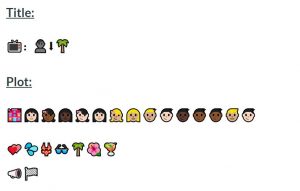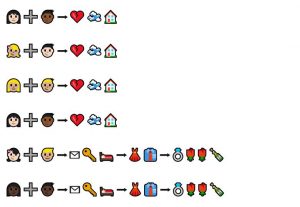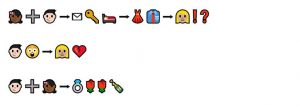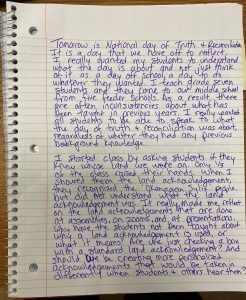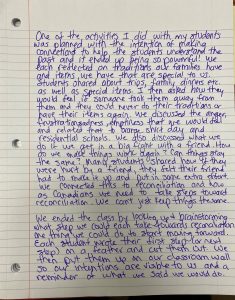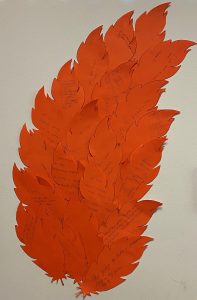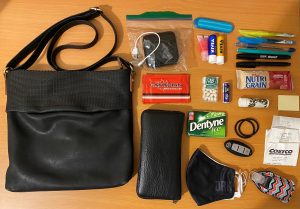For this task, I used the voice-typing feature in Google docs. I turned the microphone on and then put my screen at 45 degrees so I could not see the typing while I was talking. Here is what was transcribed:
Hi everyone! I am going to tell you a little bit about my family. We are a very busy family of four people. There is my husband myself my daughter and my son. My daughter is almost 12 years old and this is her first year of middle school. She is attending the middle school that I work at so it is an interesting Dynamic this year having her at my work. My daughter is a soccer player and plays soccer twice a week. On Tuesdays when she is not at soccer, she goes to dance class and takes a hip hop dance class. My son is 10 years old and in grade five. This is the first year of elementary school that he does not have his sister with him and he is very happy to be on his own and more independent. My son is obsessed with hockey. He has been obsessed with hockey since he could walk. He is always practicing his hockey working out or going to hockey practices and games. When he has some down time he can be found biking playing in the neighbourhood or playing spike ball in the backyard. My husband is someone who really enjoys working out. Many days throughout the week he can be found working out in our garage or Fitness room. When he has extra time he is putzing in the yard and doing things around the house. My husband also coaches hockey. In the past he has coached older kids but this year he will be coaching our son for the first time. They are both really looking forward to being out on the ice and enjoying hockey which is a passion for both of them. I spend a lot of time doing school and Masters. I work in a middle school that is great 729 and teach a variety of grades and subjects. This year I have mostly grade sevens and teach English 7 social studies 7 pe7 careers 7 + yearbook 9. This is the first year that my children both walk to and from school and so I have the ability to go to work and leave when I would like. This is very different for me when I am done work you can usually find me as a taxi driving my children to all their activities. Pre covid I used to attend boot camp many mornings unfortunately I have gotten out of that routine now and I’m not working out in the mornings. It is something that I would like to start doing again this year. My parents live in town and we see them often. They often help out and we visit them or they come and hang out with the kids when they can. During the school year we are very busy between activities and sports we are always on the go try to fit everything in. During the summer we have some more down time and we spend lots of time going camping. We enjoy camping all over the Okanagan and the kids love to bring their bikes and kayaks when we go. That’s a little bit about me and my family!
When I finished and read over the text, I noticed that my text was missing some of the conventions of written English, such as commas. I knew that I needed to “say” the end punctuation when I was using voice-typing, but I had not considered commas. As a result, many of my sentences are long and lack the breaks that a comma provides the reader. When speaking, I paused in many spots, but the voice-typing program did not interpret that as a pause because I didn’t specifically say “comma.” Another thing I noticed was that there were also other instances where the meaning of the text differed from the intended meaning. For example, I had said that I work in a middle school that is grades 7 to 9. The voice-typing wrote that “I work in a middle school that is great 729 and teach a variety of grades and subjects.” This slight deviation changed the intended meaning. It doesn’t tell the reader the grades that are in the school and it instead tells the reader that the middle school I work at is great. While that is true, it may not have been the case. This slight deviation from the intended meaning demonstrates the power our words have and how a minor change can result in a completely different meaning. The majority of the text, on the other hand, was transcribed fairly accurately. I was impressed at how few mistakes there were! The mistakes that stood out to me the most were the lack of commas and the text that was written differently than intended. I consider these mistakes because they both change the text from the original form. The lack of commas change the fluency and flow of the text, and at times, could also change the meaning. I would consider the text that was written differently a mistake because it was not what I had intended for it to say. Both of these mistakes resulted in a different interpretation of the text than were originally spoken and intended.
If I had scripted the story, I think it would have made a big difference. My text jumps around from one idea to the next and the language used is very basic. A scripted story would have allowed the ideas in the text to go deeper and be described in more detail. I found that when I was speaking and ended each sentence by saying the end punctuation, it threw off my train of thought. It made my speech choppy and I had a hard time developing my ideas because I was also focusing on the end punctuation and making sure I didn’t miss saying it. If the text had been scripted, however, the ideas would have been developed and it would have allowed me to organize my train of thought easier.
I think oral storytelling and written storytelling differ in the way they are passed on, as well as in the structure of the stories themselves. With oral storytelling, the story lives in people’s minds and is past on to future generations from person to person. Should the story not be passed on to the next generation, the story would disappear and be lost forever. In more recent years, technology has allowed for oral stories to be recorded and has allowed oral stories to be shared further away and for longer periods of time. Written storytelling, on the other hand, is passed on through the medium in which it was written. It can bypass a generation or more, and yet still survive. A clay tablet, for example, can be buried for years and still share its stories years later once uncovered. In our digital world, a written text online will live forever in cyberworld and will never disappear. This is also demonstrated by the fact that “until the development of modern recording and broadcasting techniques, writing could reach a larger audience than the spoken word, and continue to communicate to people over a long period of time” (Gnanadesikan, 2011, pg. 5). Oral storytelling and written storytelling also differ in the structure of the stories. Oral storytelling has a free-flowing structure. The story has the same meaning and same general structure, but the storyteller makes it there own through the vocabulary chosen, where the pauses are, and the voice(s) that are used in telling the story. Written storytelling, on the other hand, “is generally done more deliberately than speaking, so finished written pieces are much more carefully crafted than a typical spoken sentence. Written texts can thus convey their message more precisely” (Gnanadesikan, 2011, pg. 5). A last point to ponder is the difference that occurs when a story is transcribed from an oral story into a written story. While the written text may be the same as the spoken text, the story can be different. Anthropological linguists “theorized how transcribing spoken utterances, conversations, and oral performances altered the interpretations of spoken discourse” (Schmandt-Besserat, 2009, pg. 2). This is because “although writing represents information about how words are pronounced, it does not record the identifying details of any individual utterance of those words. It records language but not actual speech… much information about the actual speech is lost, such as intonation and emotional content” (Gnanadesikan, 2011, pg. 9). Oral storytelling and written storytelling both have their advantages and are both a powerful tool for sharing a message, but they are also very different from one another.
References
Gnanadesikan, A. E. (2011). “The First IT Revolution.” In The writing revolution: Cuneiform to the internet (Vol. 25). John Wiley & Sons. (pp. 1-10).
Schmandt-Besserat, D. (2009). “Origins and Forms of Writing.” In Bazerman, C. (Ed.). Handbook of research on writing: History, society, school, individual, text. New York, NY: Routledge.

